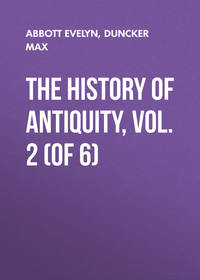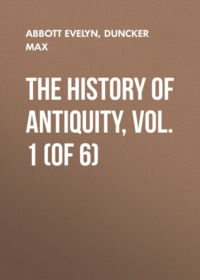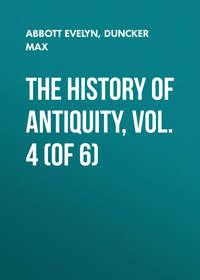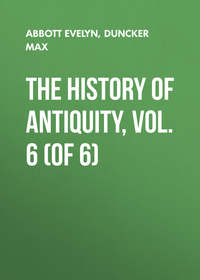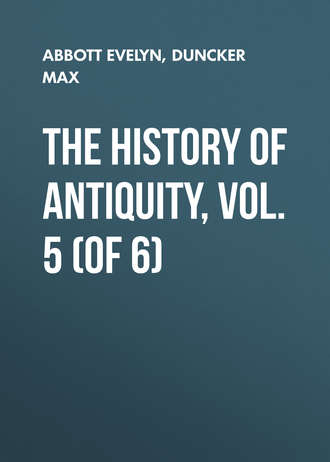 полная версия
полная версияThe History of Antiquity, Vol. 5 (of 6)
In an invocation in the Avesta we are told that the bright gleaming majesty in the form of the bird Varaghna had passed from Yima when he began to love lying speech. Yima fell terrified to earth, and Mithra, the lord of wide pastures, seized the majesty. When it passed a second time from Yima, Thraetaona seized it, and when it passed a third time, Kereçaçpa seized it.
The second who crushed the juice of the Haoma was Athwya. Hence there was born to him a son, Thraetaona, in the land of Varena. The evil spirit Angromainyu had created a wicked being, "with three heads, three throats, six eyes, and a thousand strengths" – the Azhi dahaka, i. e. the biting serpent, which swallowed horses and men, and threatened to desolate the world. But Thraetaona sacrificed a hundred horses to Ardviçura, a thousand oxen, and ten thousand head of small cattle, and called on the goddess, and with bound bundle of rods, on Vayu on his golden throne, with golden footstool and golden canopy, to grant that he might smite the strong Druj, which Angromainyu had created as the strongest to bring death upon the pure world; and he overcame the monster, because Verethraghna was with him, the most victorious of mortals.56 And Thraetaona obtained the splendour of the dominion when it departed a second time from Yima. In the prayers of the Avesta, Thraetaona, who has slain the great serpent, is invoked as helper against the "pain which is caused by the serpent," against fever and sickness.57
The third who crushed the juice of the Haoma for the sacrifice was Thrita, of the race of Çama. Thrita was the first who by skill in medicine kept back sickness and death from the bodies of men. He wished for means to withstand the pains, the sickness, the death, the hot and cold fever which Angromainyu had created for the bodies of men. "Then I, Auramazda, caused healing plants to grow by hundreds, by thousands, by tens of thousands around the one Gaokerena." And in reward for his offering of Haoma two sons were born to Thrita – Urvakshaya, who put in order the law, and Kereçaçpa (i. e. having slim horses), the youth of beautiful form, the bearer of the weapon Gaeçu.58 Kereçaçpa smote the poisonous green serpent Çruvara, on which flowed poison to the thickness of a thumb, and it swallowed men and horses. Afterwards, after he had sacrificed to Ardviçura on the shore of Lake Piçano (i. e., no doubt, in the valley of Pishin in Sejestan), he smote the giant Gandarewa, who dwelt in Lake Vourukasha, and the descendants of the nine robbers, and Çnavidhaka, who had attempted to overcome Auramazda and Angromainyu. And when his brother Urvakshaya had been slain by Hitaçpa, Kereçaçpa besought the wind, who works on high, to grant to him to slay Hitaçpa in revenge for the death of his brother. And he conquered him, and yoked him to his chariot. When for the third time the majesty departed from Yima, Kereçaçpa seized it, the strongest of men after Zarathrustra. In the prayers of the Avesta, Kereçaçpa's help is invoked against robbers and hostile hosts.59
Yima, Thraetaona, Kereçaçpa, and the forms which are genealogically connected with them, Vivanghana, Athwya, Çama, Thrita, and Urvakshaya, are collected by the Avesta under the name Paradhata, i. e. those who first exercised dominion.60 Indications in our fragments show that other names were also included in them. Thraetaona's son was Airyu, and Airyu's son was Manuschithra.61 These most ancient sovereigns were followed by a second group, whose distinguishing mark is the surname Kava. The first of these Kavas, whom the Avesta mentions merely as the wearer of the divine majesty, is Kava Kavata.62 He is succeeded by the agile, brilliant Kava Uça, who sacrifices to Ardviçura on Mount Erezifya in order to obtain the dominion over all lands, over Daevas and men, wizards and Pairikas, and this favour the goddess granted him. After Uça the royal majesty united itself, to use the phrase in the Avesta, with the beautiful pure body of Kava Çyavarshana. He died by a violent death.63 His son was Kava Huçrava, "the brave uniter of the Arian lands into one kingdom," as the Avesta tells us, which then goes on to relate that he was without sickness or death. He had to contend against the destructive Franghraçianas, the Turanians (tura, tuirya). He besought Ardviçura that it "might be granted to him to put an end to the long dimness, and bind the Franghraçianas in their abundance and pride." This prayer the goddess granted. Haoma himself desired "to bind the destructive, murderous Franghraçiana and carry him away as a captive of the king Huçrava, and that Kava Huçrava should slay him behind the lake Chaechaçta, the deep lake with broad waters."64 Kava Huçrava was followed by king Aurvataçpa, the son of Naotara, the son of Manuschithra, the son of Airyu; and Aurvataçpa was succeeded by his son the strong and warlike Vistaçpa.65 Of the twenty-nine sons of this king, the Avesta mentions the strong Çpentodata, and informs us that Frashaostra and his brother Jamaçpa, of the race of Hvova, were men of importance with the king. Like Huçrava, Vistaçpa had to contend with a Turanian, Arejataçpa, i. e. the winner of horses, who sacrificed to Ardviçura in order to obtain the victory over Kava Vistaçpa and the warrior on horseback, Zarivairi (the brother of Vistaçpa). The goddess heard him not, but heard Vistaçpa when he sacrificed to her behind the water of Frazdana, in order to overcome the hostile Arejataçpa, born of darkness, skilled in evil, who sought to smite the lands of the Arians.66 But Zarathrustra, the son of Pourushaçpa, of the race of Haechataçpa, sacrificed to Ardviçura that he might unite with the mighty Vistaçpa, the son of Aurvataçpa, and to Drvaçpa, "that he might unite with Hutaoça, and she might impress on his memory the good law."67 Zarathrustra proclaimed a new law, the law of Auramazda. The heroes and kings before him were known in the Avesta by the name Paoiryotkaesha, i. e. the men of the earliest custom, the earliest law.
These are all the traits and pictures of the antiquity of East Iran, of any importance, which can be gathered from the remaining fragments of the Avesta. Of the antiquity and genuineness of the narrative there is no doubt. The close relationship and coincidence which they exhibit with the form and views of the Veda are proved on both sides. As we saw, the Veda distinguishes the sacrificers and sages of the ancient time, the earlier time, and the present (IV. 29.) The god Haoma is the well-known god Soma of the Arians in India, the variation in the name being due to the change of sounds which distinguishes the Old Bactrian from the language of the Veda. Here, as there, he is the sacrificial libation, and at the same time the god who pours the libation, and is its power. The great heroes Yima, Thraetaona, Kereçaçpa and Zarathrustra were born to their fathers as a reward for offering the libation of Soma. King Yima (Yima Kshaeta) in the Avesta is no other than the Yama (Yama Rajan) of the Veda. Yama is the son of Vivasvat, the brilliant, the shining, the giver of light; and in the Avesta Yima is the son of Vivanghana. In the Veda he is the assembler of the people, the first king, the first mortal who shows to men the way which leads from the depths to the height of heaven; who first experiences death, but returns into heaven as the son of the god of light, where he gathers round him the brave and pious for new life in imperishable joy (IV. 61). Yima is also the assembler of men, the first king; he rules with the golden staff; he founds the religious worship, a merit which in the Veda belongs to Manu. Under Yima the earth is filled with red-glowing fires; he worships Vayu and Ardviçura. He is the representative of the golden age; in his reign there is neither heat nor cold, age nor death, hate nor strife; and his dominion continues a thousand years. It was the first happy period of the world, which men passed under the dominion of the son of the god of light. At what an elevation Yima must have been placed in the oldest form of the mythus of East Iran is clear from the fact that creative acts and the triple extension of the earth are ascribed to him. After the close of this golden period, winter comes upon the earth, heat and cold, strife, sickness, and death. The happy life of the golden age only continues within certain limits, in the enclosure of Yima, where he carries on the blessed and immortal life with selected men, trees, animals, and food. Here Yima is to live till the end of all things, when his companions will again people the earth. As in this garden of Yima the sun, moon, and stars shine together,68 it must be sought in the sky, or at any rate on the bright, divine mountain Hukairya, where there is neither night nor gloom, and which is at the same time described as Yima's place of sacrifice.
If the Indians have placed the old Arian legend of a golden age on earth in the days of Yima's reign, they have also, after their manner, depicted his heavenly kingdom with brighter colours, while among the Iranians this part of the legend is combined with the heavenly garden into which Yima receives the men he has selected as the best. Nevertheless, a reminiscence of Yima's garden has remained beyond the Indus in the story of the Uttara Kurus, who dwell beyond the holy mountains to the north.69
The most striking variation from the common Arian myth in the Avesta is the statement that Yima is subordinate to a deity, Auramazda, of whom the Arians of India knew nothing. The old legend is thus brought within the sphere of new views, which must have exercised still further influence upon it. It is Auramazda who places in the hand of Yima the control, superintendence, and protection of animals and men. It is not through Yima's own desire, as was certainly the case in the old legend, but at Auramazda's bidding, that the enclosure is made, and the selected men, animals, and trees brought into it. The main reason for this change was the necessity of giving an answer to the question, Why did not the golden age continue? and if, long after Yima, Zarathrustra proclaimed a new and better law, why had not Auramazda revealed this law to the favoured Yima? In order to answer this riddle, the Avesta represents Auramazda as asking Yima to become "the preacher and bearer of his doctrine," and Yima refuses to accept this mission. Hence Yima becomes guilty of a fault, and a reason is given why the golden age, the thousand years of the reign of Yima, came to an end. Without the good doctrine, the invasion of evil spirits, and with them of heat and cold, sickness and death, strife and blight, could not be kept back from the earth. This trait of the guilt of Yima, which is entirely unknown to the earlier legend, is carried out still further. According to the prayer in the Avesta (p. 34) blessing and immortality continued in the kingdom of Yima, "till he began to love lying speech." When he had rejected Auramazda's law he cannot himself resist the seduction of evil spirits. The first offence brings on the second, and this causes the triple loss of majesty, which at length ends in the fall and violent death of Yima, an incident already indicated in the Avesta.70 How this form of the legend allowed the garden of Yima to be placed on the divine mountain, and whether the contradiction was removed or not, our fragments do not enable us to decide.
In the Veda it was Indra who had to contend against Vritra and Ahi, i. e. the serpents, and the black spirits, which desired to drink up the water of the sky and veil its light. In Iran, as we shall see, this office is transferred to other spirits, and also to Thraetaona. The Azhi dahaka of the Avesta is the Ahi of the Veda. Ahi and Azhi are the same word, with the same meaning; the addition dahaka refers to the destructive power of this demon. Verethraghna, i. e. the slayer of Vritra, stands in the Avesta at the side of Thraetaona in his struggle with Azhi (p. 35), and the morning wind supports him just as in the Veda the winds assist Indra against Ahi and Vritra. Among the Indians, Traitana is a spirit of the air, who dwells in the remotest regions of the sky, who hews off the head of a giant from his shoulders, and in the Veda, Trita, the son of Aptya, drinks the draught of Soma, in order to win strength for the slaying of Vritra; he slays the snake with three heads and seven tails; with his iron club he splits the hollows in the rock in which the demons have hidden the cows of the heaven (the rain clouds).71 In the Veda, Aptya is the father of Trita; in the Avesta, Athwya is the father of Thraetaona. Of Trita, whom it represents as sprung from Çama, the Avesta declares that he was the first physician; in the Veda we are told of Trita he knew how to heal sickness as the gods had taken his sickness from him; that he bestowed long life.72 The two figures of Trita and Traitana gradually unite in the Veda; in the Avesta, Thrita and Thraetaona remain separate persons. The Kereçaçpa of the Avesta seems to correspond to the Kriçaçva of the Indians, whom we first find in the Epos, where he is celebrated as a warlike Rishi.73
If the Paradhatas, Yima, Athwya, Thraetaona, Thrita, and Kereçaçpa in the original conception are spirits of the sky, if the monsters with which Thraetaona and Kereçaçpa struggle are not to be sought on earth but in the heavens, if in these dragons we find once more the cloud-serpents, against which Indra and his company have to contend – we do not at once set foot upon earth, when we come to the Kavanians. According to the later tradition of Iran, Kava Kavata was fetched from the divine mountain in order to reign over the country; two white falcons bring him a golden crown. The Rigveda mentions Kavya Uçanas, i. e. Uçanas, the son of Kavi, who brings the cows of the sky, i. e. the clouds, to the pasture.74 In the Avesta, Kava Uça sacrifices not only to rule over the whole earth but also over the spirits. According to a later tradition this sovereign – now called Kai Kaus – causes beautiful castles to be built on the divine mountain by the demons, and is then carried by four eagles into heaven. Kava Huçrava, for whom in the Avesta the god Haoma contends, is without sickness and death (p. 37). In the later tradition, in which he is known as Kai Chosru, he begins a pilgrimage to heaven after conquering and slaying his opponent the Turanian Franghaçiana, like the sons of Pandu in the Mahabharata after their victory over the Kurus and their happy reign. Like them also, Kai Chosru climbs the mountains and disappears from his companions at a well. Against his command they seek him in the mountains, and are all buried in a great snow-storm. From the name Manuschithra (p. 37), i. e. scion of Manu, we may conclude that the twin brother of Yama, "father Manu," was not unknown to the Arians of Iran. But the genealogy in which the Avesta has preserved these names has no greater claims to historical value than the figures which have passed in review before us. Airyu is the son of Thraetaona; i. e. from the mightiest hero, the slayer of the great dragon, are sprung the sovereigns and the nation of the Airyas; the son of Airyu is Manuschithra; from whose son, Naotara, are derived the two last Kavas, Aurvataçpa and Vistaçpa.
If the coincidence of the forms from Yima to Kava Huçrava with the Veda is a proof of the antiquity and genuineness of the tradition of the Avesta, the gain for history becomes less instead of greater. No one would take mythical persons for historical. Yet the style and form in which we find these traditional statements in the fragments of the Avesta supply certain guides for the lost history of Eastern Iran. The splendour of the royal majesty is so often and so distinctly brought into prominence, that the conclusion forces itself upon us, that the regions in which the Avesta arose, i. e. the north-east of Iran, must have been acquainted with a powerful and highly-respected monarchy. The ancient spirits of the sky are changed in the Avesta into mighty warriors and far-ruling kings, a circumstance in favour of the supposition that an empire once existed here, the image of which is reflected on prehistoric times. It is in Epic poems that the spirits of the first sky become heroes, and Epic poetry only arises in and follows on periods of war and conflict. The fact that the forms of the spirits thus changed into heroes by Epic song are turned into the forefathers of the kings and progenitors of the nation, further establishes the conclusion that a military monarchy must have been in existence here; only warlike princes could appear as the heirs of heroes. Moreover, the Avesta extols the high banner of Bakhdhi and speaks of the neighbouring regions as favoured; the later tradition of Iran marks out Bactria very clearly as the abode of Aurvataçpa and Vistaçpa; in the third century B.C. Bactria supplied its princes with means not merely to achieve their own independence, but to maintain it against the great kingdom of the Seleucids and to subjugate the land of the Indus (p. 25 ff.); and if, in addition to these facts, we bear in mind the conceptions found in the Median poems of the great power of the kings of the Bactrians, their treasures in gold and silver, their fortified city, the conquest of which was the greatest achievement of Ninus – we may venture to assume that before the days of the Medes, i. e. before the year 650 B.C., there must have existed an important monarchy in the north-east of Iran.
With the assistance of the Avesta we may go a step further. We saw that Kava Huçrava no less than Vistaçpa is represented as fighting against the Turas or Tuiryas. Who were these enemies? In Old-Bactrian the word means the enemy, the oppressor. Strabo speaks of a region of Turuia in the north of Parthia, towards the steppes of the Oxus.75 In the later tradition of Iran the Turanians are the constant and most dangerous enemies of the kings of Bactria. The steppes of the Oxus and Jaxartes were inhabited by nations to whom the Persians gave the collective name of Sacæ, while the Greeks called them Scythians. They found but scanty pasture on the steppes, and it was natural that they should look with longing eyes on the more fertile regions of Bactria and Sogdiana. It has already been mentioned how careful Cyrus was to protect these countries, when he had conquered them, against the nations of the steppes. At a later time, from the middle of the second century B.C. downwards (p. 28), we have definite information of the pressure of these nations on Parthia, Margiana, and Bactria. When freed from the attacks of the Seleucids on the west, the Arsacids had to defend the east of the kingdom. Phraates II. and Artabanus II. fell in battle against the nomads; Mithridates II. succeeded in protecting Parthia, but about the year 100 B.C. the Sacæ were able to force a way through Bactria. They possessed themselves of the best land in the east of Iran, the valleys of the Hilmend (p. 7), bequeathed their name to the country (Sikashtan, Sejestan), and from the valley of the Cabul extended their dominion beyond the Indus. The white Huns, or Yuëchis, followed the Sacæ; and they also reached the Indus. Is there any reason to doubt the Avesta that even before the Medes and Cyrus the princes of Bactria and Sogdiana were occupied with beating back the tribes of the steppes?
In ancient times, as Strabo tells us, the Bactrians and Sogdiani were little removed from wandering shepherds. The Avesta exhibits them in close connection with horses. The names compounded with açpa (horse) are common; Kereçaçpa, Aurvataçpa, Vistaçpa, Haechataçpa, Jamaçpa, Pourushaçpa. Of Zariaçpa and the Zariaçpians we have already spoken. The most important source of wealth must have consisted in horses, for which the mountains supplied ample pasture. The horse-sacrifice is the chief sacrifice of the Avesta. One hundred horses were equal to 1000 oxen, and 10,000 head of small cattle. We found that Bactria could furnish the last Darius with 30,000 cavalry, and the horse was the symbol of Bactria on the coins of the Greek princes of the land (p. 27).
From all these indications we may assume that when the Arians had settled in Margiana, Bactria, and Sogdiana, and agriculture became of importance beside the breeding of cattle, the necessity of protection against the migratory tribes of the endless plains stretching to the north, created among the Arians a warlike nobility who took upon themselves the duty of defence. The valley of the Zarefshan (Sogdiana), the terrace of Bactria, the region of Merv, became in the hands of the Arians advanced posts of civilisation in the desert. If Western Iran was protected in the north by the Alps of Aderbeijan and the Caspian Sea against attacks from that quarter, Eastern Iran lay open to the nomads of the steppes, and had nothing but arms to defend its cultivated lands. We have already seen that Bactria even in the sixth century had passed beyond the earliest stages of civilisation (p. 24). But even a less degree of prosperity was sufficient to excite the sons of the desert to invasion. Hence we may assume that the incursions and raids of the nomads of the steppes began with the increase of the flocks and the prosperity of agriculture in the valleys of Merv, Bactria, and Sogdiana. The increasing severity of these attacks compelled the Bactrian soldiery to collect their forces for more successful resistance, and to place the best warriors at the head of the community. Thus it was not by spontaneous development, but rather by the opposition to the nations of the steppes, that the north-east of Iran first outgrew the tribal life, and became transformed into a larger state. Of this kingdom Aurvataçpa and Vistaçpa became the rulers; in the Avesta they are distinguished from the Paradhatas and from Kava Kavata, Kava Uça, and Kava Huçrava, by a new addition to the name and other peculiar traits, and form a third group. The progress of our investigation will show that the formation of this Bactrian kingdom cannot be placed later than 1100 B.C.; the date of Vistaçpa must be put about 1000 B.C., and it was the successors of Vistaçpa who sent to Shalmanesar II. the tribute of camels with two humps, and yaks (about 850 B.C.), who found themselves menaced once more by the advances of Tiglath Pilesar II. to Arachosia in the year 745 B.C., and at length succumbed to Cyrus. We shall find that this kingdom was not without its warlike races and priestly families, that Zariaçpa and Bactria were the centres of it, and that the sovereigns attained despotic power. Yet the old warlike families must have preserved a certain importance under the monarchy, unless they regained it when lost under the viceroys of the Achæmenids. It was the chieftains of the Bactrians whom Alexander summoned to Zariaçpa, and who with the Sogdiani at their side took the lead in resistance. The most powerful of them stubbornly defended their rocky citadels against the Macedonians.
CHAPTER III.
THE SCRIPTURES OF IRAN. 76
The statements of the Avesta concerning the ancient rulers of Eastern Iran were proved to be without historical value, yet we found in them an ancient and genuine tradition, the form of which allowed us to draw certain conclusions about the political condition of that region in a period for which we have no other records except the poetry of Western Iran. But what the Avesta tells us of the rulers of ancient days is of secondary importance for the book, which comprises the doctrines and ordinances of the faith proclaimed by Zarathrustra, and the rules of life which he is said to have laid down. May we assume that we possess these in a genuine and unaltered form in the Avesta, though they have only come down to us in fragments?
A book of the Parsees of India, which tells the story of their flight from their ancient home, relates that Iskander (Alexander of Macedon) burned the revealed scriptures, and the faithful were persecuted for 300 years. When Ardeshir (the first Sassanid) ascended the throne, the true faith was restored, under the superintendence of Arda Viraf. After this the true religion was again suspended till king Shapur (Shapur II.) rose and once more made the faith famous, and Aderbat Mahresfant girded his loins in the good cause. The same account is given in the Book of Arda Viraf, also a book of the Parsees of India. From this we learn that the religion received by the pious Zarathrustra lasted for 300 years in purity. Then the evil one stirred up Iskander Rumi, so that he spread war and devastation over Iran, and slew the rulers of the land. The Avesta which was preserved at Stakhar Papakan (Persepolis), written on cow-skins with golden ink, he burned, and put to death many priests and judges, pillars of the faith, and spread hatred, strife, and confusion among the people of Iran. They had now no lord, guide, and high priest, who knew their religion; they were full of doubts and had different modes of belief and worship of various kinds, and different laws prevailed in the world till the time when Ardeshir came to the throne and listened to the words of the holy Arda Viraf and believed him. But after Ardeshir's death a schism broke out, and more than 40,000 souls fell away from the true faith, till the day when the holy Aderbat Mahresfant arose.77 An older writing of the Parsees, the Dinkart (composed under the Sassanids), tells us, apparently on the ground of a proclamation of the Sassanid Chosru Parvez (590-627 A.D.) that king Vistaçpa of Bactria had commanded that all books which were written in the language of the Magians should be collected, in order that the faith of the worshippers of Auramazda might have some support, and all men were to go to Frashaostra (whom the Avesta mentions as a companion of Zarathrustra) to be instructed in the faith. And Darai, the son of Darai (Darius Hystaspis is meant), commanded that two copies of the entire Avesta, precisely as Zarathrustra had received it from Auramazda, should be preserved, the one in the treasury at Shapikan, and the other in the city of scriptures. Then Valkosh (Vologeses), the descendant of Ashkan (Arsaces), gave orders that so much of the Avesta as had escaped destruction and the ravages of Iskander and the warriors of Rum, and existed in fragments or in oral tradition, should be sought out and brought from every city. And king Artakshatr (Ardeshir) summoned the Herbedh (i. e. the priest)78 Tosar with the holy scriptures, which were scattered, to his residence, and when Tosar came he gave command to the other priests that everything, which differed from that which was now considered to be knowledge and wisdom, should be suppressed. The son of Artakshatr, Shapuhar (241-272 A.D.), the king of kings, gave command that all writings on medicine or astronomy or other subjects in Hindostan, Rum, and other lands, should be collected, and again united with the Avesta, and that an exact copy should be deposited in the treasury of Shapikan. Lastly Atropat (Aderbat) in the reign of Shapuhar (Shapur II, 309-379 A.D.), the son of Auharmazdi, purified the sayings of Zarathrustra and enumerated the Nosks (chapters) of the sacred scriptures.79




